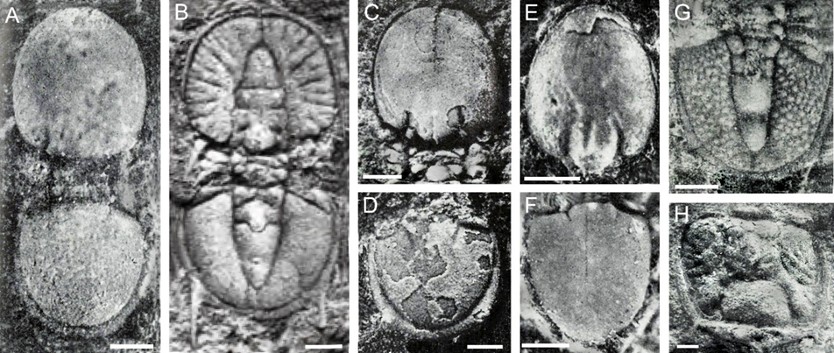Mohershan Fm
Type Locality and Naming
The type section of the Mohershan Formation is the Mohershan section, situated on the north slope of the Mohershan Mountain in the border area between Yuli and Heshuo counties, Bayingolin, Xinjiang Uygur Autonomous Region (88°21’05”E, 41°24’20”N). It is also the type section of the overlying Mohershan Formation. It lies 35 km southeast of Qinggir Village or about 40 km northeast of Xingdi Village, and was measured by Zhang et al. (1959). The Mohershan Formation was first published by Zhang et al. (1959). It is the upper portion of the same section shared by the underlying Mohershan and Xidashan formations. The name is derived from Mohershan Mountain, about 35 km west of Qinggir Village in Yuli County, Bayingolin Mongolian Autonomous Prefecture, Xinjiang Uygur Autonomous Region. The name originally appeared in a 1957 manuscript by Deng Zihua et al from No. 722 Geological Team of Xinjiang Bureau of Geology. Originally it was called Mohershan series, subsequently renamed Mohershan Group by Xinjiang Regional Geological Survey Team (Hu et al. 1965a), and lowered in rank as Mohershan Formation by the No 5 Brigade of Xinjiang First Regional Geological Survey Team (Hu et al., 1965b).
Synonym: (莫合尔山组)
Lithology and Thickness
The Mohershan Formation is a carbonate sequence with minor interbeds of clastic rocks. Lower part of formation consists of thin-bedded calcareous mudstone, argillaceous limestone bearing siliceous bands. Upper part consists of limestone, intercalated with edgewise conglomerate or brecciated limestone. The lower part often changes in facies into sandy limestone, limestone breccia, and siltstone.
Relationships and Distribution
Lower contact
The Mohershan Fm rests conformably on either the Xidashan Fm in northern Kuruktag. The thin-bedded limestone and calcareous shale at the base of the Mohershan Fm is clearly distinguished from the underlying black siliceous rock of Xidashan Fm or the underlying black dolomite of Yardangshan Fm.
Upper contact
The upper boundary of the Mohershan Formation in northern Kuruktag is not so clearly distinguished from the overlying Torsuqtagh Fm in lithology because the boundary interval comprises merely thin-bedded limestone. Usually, the boundary is marked by change of rock color from dark grey to light grey limestone. In southern Kuruktag the upper boundary is marked by lithology changes, from black shale or black calcareous shale at the top of Mohershan Fm to dark grey, medium- to thick-bedded limestone of Torsuqtagh Fm.
Regional extent
The Mohershan Formation is exposed in the east of Southern Tianshan Area of Tarim Region, distributed in the south and north slopes areas of the Kuruktag Mountain. The thickness of the formation ranges from 72 to 700 m.
GeoJSON
Fossils
The lower part of Mohershan Formation in northern Kuruktag area yields trilobites Bailiella sp., Dorypyge sp., Dinesus sp., Fuchois sp., Granularia sp., Jiumenia sp., Olenoides sp., Oryctocephalites sp., Paramecephalus sp., and Xingrenaspis sp. The middle and upper parts yield rich trilobites. In northern Kuruktag area, the formation embrace five trilobite zones, from bottom up: 1, Ptychagnostus atavus Zone containing only P. atavus; 2, Ptychagnostus punctuosus Zone containing only P. punctuosus in the type section, but yields also Corynexochus sp., Doryagnostus sp., Dorypyge sp., and Fuchoia chiai in other sections; 3, Yakutiana triangularis Zone containing Diplagnostus planicauda, Dorypyge richthofeni, Fuchouia oratolimba, Goniagnostus spiniger, Hypagnostus hunanicus, Lisania sp., Peronopsis sp., Ptychagnostus xinjiangensis, Yakutiana dubia, and Y. triangularis; 4, Lejopyge armata Zone containing Amphoton sp., Aojia sp., Clavagnostus sp., Cyclolorenzella sp., Dorypyge richthofeni, D. sp., Diplagnostus brevis, D. planicauda, Eoshengia sp., Fuchouia chiai, F oratolimba sp., Goniagnostus spiniger, G. sp., Hypagnostus brevifrons, H. corectus, H. hunanicus, H. nepos, Lejopyge armata, L. laevigata, Linguagnostus sp., Lisania tungienensis, L. sp., Paradamesella sp., Parablackwelderia latirilobotus, Paranomocarella sp., Peronopsis sp., Prodamesella?sp., Prohedinia sinensis, P. sp., Pseudagnostus qurugensis, Ptychagnostus xinjiangensis sp., P. sp., Solenoparia sp. , and Yakutiana dubia. In other section the formation yield additional Ptychagnostus aculeatus; 5, Lejopyge sinensis Zone containing Acmarhachis sp., Agnostascus sp., Buttsia globosa, Distazeris sp., Eoshengia sp., Fuchouia oratolimba, Goniagnostus fumicola, Huzhuia sp., Hypagnostus brachydolonus, Lejopyge sinensis, Oidalagnostus trispinifer [= O. tienshanicus], Paradamesella decemospinosa sp., Parablackwelderia jimaensis, Phalagnostus sp., Protaitzehoia sp. and Tomagnostella jiangshanensis. In other sections the formation yields conodonts Gapparodus bisulcatus, Prooneotodus tenuis, P. terashima, and P. aff. tenuis.
In southern Kuruktag area, the lower and middle parts of Mohershan Formation yield sponge spicule Protospongia sp., small shelly fossils Quadrachides sp. and Hyolithellus sp. and fragments of radiolaria and bivalve as well. Only three trilobite zones are recognized from the upper of the formation, from bottom up: 1, Ptychagnostus punctuosus Zone containing Ptychagnostus punctuosus, Yakutiana triangularis, and Y. dubia; 2, Lejopyge armata Zone containing Goniagnostus sp. Lejopyge armata, L. laevigata, Yakutiana dubia, Ptychagnostus aculeatus and P. sp. This zone yields also conodonts, Gapparodus bisulcus, Furnishina furnishi and Prooneotodus tenuis; 3, Lejopyge sinensis Zone containing Ajrikina sp., Agnostascus sp., Goniagnostus fumicola, Lejopyge sinensis, Oidalagnostus tienshanicus, and Proceratopyge sp.
[Figure: Some index fossils of the Mohershan Formation, all from the Charchaq (Queerqueke) Mountain, Xinjiang Uygur Autonomous Region A, Yakutiana [=Pseudophalacroma] dubia (Whitehouse, 1936), exoskeleton, from the Yakutiana triangularis Zone; B, Goniagnostus spiniger (Westergård, 1931), exoskeleton, from the Yakutiana triangularis and Lejopyge armata zones; C, D, Lejopyge armata (Linnasson, 1869), cephalon with thoracic segments (C) and pygidium (D), from the Lejopyge armata Zone; E, F, Lejopyge sinensis Lu and Lin in Peng, 1987, cephalon and pygidium, from the Lejopyge sinensis Zone; G, Goniagnostus fumicola Öpik, 1967, pygidium, from the Lejopyge sinensis Zone; H. Oidalagnostus trispinifer Westergård, 1946, pygidium, from the Lejopyge sinensis Zone. All scale bars = 1 mm.]
Age
Depositional setting
Additional Information
